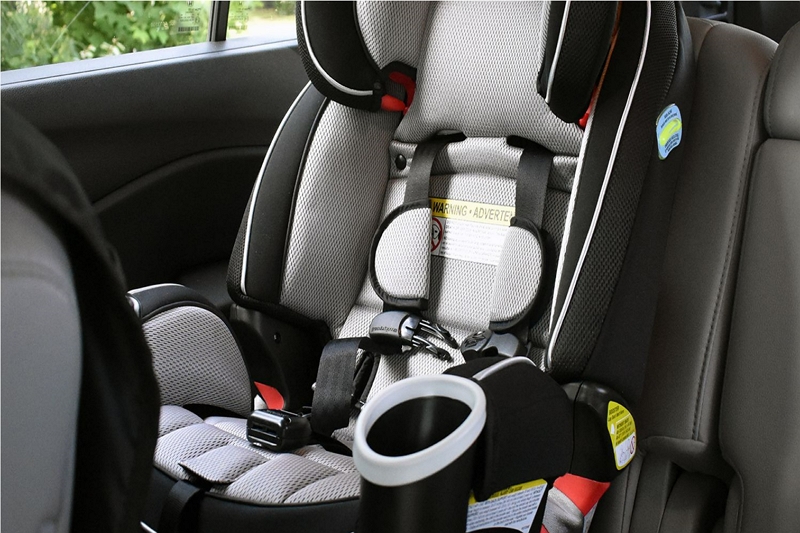When do you turn the baby car seat facing front? Your little one should be facing the front of your car seat by the time they are two years old, or whenever the maximum height and weight limit for their rear-facing baby car seat are no longer met.
To understand when this will happen for you, it’s important to know that each child has different proportions. If your son was born at 20 pounds and 30 inches long, he’ll hit his milestones much sooner than a tiny five-pounder who didn’t grow as quickly in utero.

Every child has an individual growth rate so check with your paediatrician about what is right for yours!
The American Academy of Pediatrics recommends all kids use a rear-facing infant until age two because children under 22 lbs. are five times safer riding rear-facing, and that 85-90% of leg injuries in crashes are prevented by keeping children rear-facing.
How to make a baby car seat canopy
If you are looking for a baby car seat canopy, here is how to make one.
A friend of mine just had her second child and I wanted to find something special that she could use on long drives with her little girl.
So instead of buying the usual gifts, I decided to crochet a car seat cover for them. If you can’t sew or don’t have time then this DIY project will be perfect for your gift-giving needs!
Here is what you need: One-yard white fabric (this will serve as the backing) Three yards cotton batting Two yards flannel in coordinating colors Scissors A sewing machine Thread Needle Ribbon This is very simple and easy and it makes an amazing gift!
To begin cut the batting into two pieces of the same size. Layer them together and sew around all four sides, leaving one end open.
Turn it right side out so that the seams are hidden on the inside of your “tube” Sew or serge (if you have a sewing machine) along three sides but leave an opening at one end to pull through your flannel fabric for decorating.
Cut off any excess seam allowance from each corner before turning it right-side-out again! Now cut your coordinating color flannel to fit over both layers of batting making sure there is about ½ inch extra beyond what will be sewn down; this creates enough room for stuffing.
Attach ribbon loops on either end with glue gun OR thread string/yarn onto the top layer of batting to tie it. Trim excess flannel fabric down about ½ inch beyond the end that will be sewn shut, this creates a nice clean finish.
Sew or serge all four sides closed ensuring you are leaving an opening at one end to pull through your cotton backing fabric for decorating! Cut off any excess seam allowance from each corner before turning right-side-out again and stuffing with cotton filling.
If you want to make two car seat canopies then sew or serge both pieces together matching up seams carefully so they match once completed. Flip over the wrong side out and stuff tightly with cotton filling making sure there is enough room in between the layers for sewing them completely shut being too bulky when finished; you will need to do this in steps.
Sew or serge both sides together leaving an opening at one end to pull through your cotton backing fabric for decorating!
Turn right-side out and stuff tightly with cotton filling making sure there is enough room in between the layers for sewing them completely shut being too bulky when finished; you will need to do this in steps as well.
Now attach ribbon loops on either end with glue gun OR thread string/yarn onto the top layer of batting to tie it closed. Trim excess flannel fabric down about ½ inch beyond the end that will be sewn shut, this creates a nice clean finish.
Take each corner and fold over so they meet creating a triangle shape and sewing up around all four sides.
How long can a premature baby be in a car seat?
Car seat use for premature babies is common, but there are guidelines about how long they can be safely in car seats. Premature infants should only spend the minimum amount of time possible in a car seat or other restraining device. However, if your baby needs to ride in a vehicle every day and cannot travel by aeroplane, then follow these tips:
– The child must have head control before riding rear-facing (infants usually achieve this around 32 weeks gestational age).
– Positioning devices such as wedges or rolled-up towels should not be used when placing an infant into the group 0+/I carrier because it reduces side impact protection. It is fine however to place them back against one once strapped in.
– Do not leave infants unattended in a car seat.
– Car seats should be installed according to the manufacturer’s instructions and vehicle owners manuals or those that have been approved by Transport Canada for use as infant carriers. When using aftermarket products, ensure they are compatible with your car seat model.
– The child must have head control before riding rear-facing (infants usually achieve this around 32 weeks gestational age). Positioning devices such as wedges or rolled-up towels should not be used when placing an infant into the group 0+/I carrier because it reduces side impact protection.
It is fine however to place them back against one once strapped in. Do not leave infants unattended in a car seat.
Car seats should be installed according to the manufacturer’s instructions and vehicle owners manuals or those that have been approved by Transport Canada for use as infant carriers. When using aftermarket products, ensure they are compatible with your car seat model.
